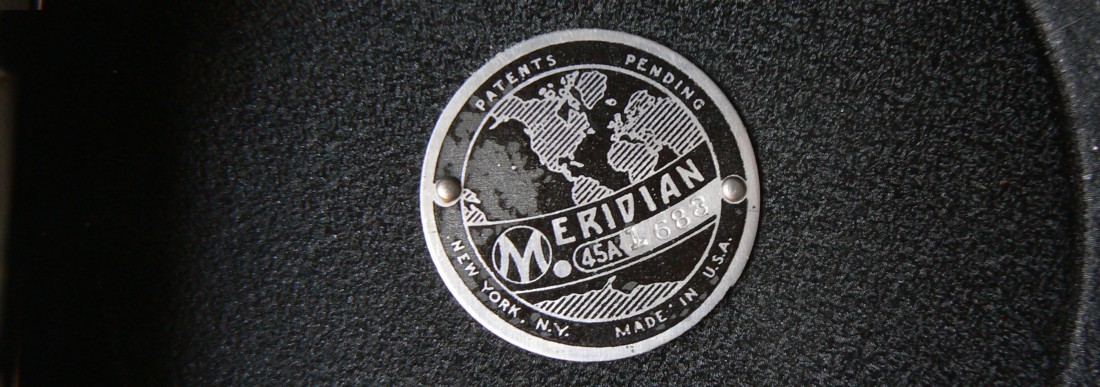
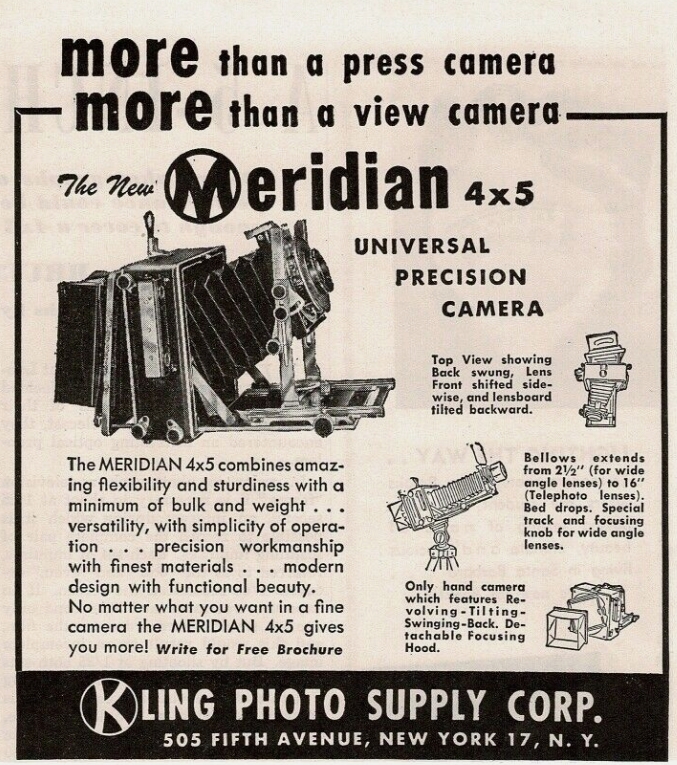
1947


A bit of History
With the support of Lou Moss,
owner of the well-known Peerless Camera Store near Grand Central Station,
and Ben Berkey who was the owner of a
large consumer photo-finishing laboratory,
Paul Klingenstein
set up the Kling Photo company.
He was a German Jew who had left Germany in 1934
for the United States.
In order to manufacture an advanced
professional camera for Peerless the company he worked for, he decided to bring
a new camera on the market.
The camera was named Meridian.
It was
intended to be an mixture of
the standard press camera of that time, the Speed Graphic, and the much more
sophisticated (but due to the war unavailable) German Linhof Technika.
Klingenstein sketched out the
camera, applied some engineering and contracted with a Lafayette Street
precision machine shop to produce 1000 cameras.
Eventually 2000 were
manufactured and sold. The Meridian "B" was designed by Victor Yager
the very same who designed and manufactured the
Vidax camera.
The patent application was filed in June 1949.
I'm proud I received some
interesting reactions on my publication.
e-mail 16th
September 2011
Helen Romanek
Hello, I am getting photos you asked for together. By the end of next week I
will e-mail you.
My dad sold his patent of the Meredian to Peerless photo which
was then bought out by Berkey Photo.
He taught photography at the New York
Institute of Photography.
In the basement, he had a milling machine, a lathe and
a drill press that I remember, and it was only his brother helping him. (I do
have pictures which I will send).
I did have a camera which I gave to my nephew,
his grandson.
He also has a box of parts to the Vidax. My dad had other patents
of things he worked on, but financially was never able to promote them
successfully.
He worked for Bessler company and the Clariex Corp before retiring
in 1964 or so. In case I forget, I made a mistake, my dad passed away in 1984
not 1977. Regards, Helen
More info
about Paul Klingenstein's life
Publication of the
New York Times and Aufbau
Although in production for only a short time, Paul Klingenstein's Meridian "B" is regarded as a classic today.
Like all the other such as
Busch, Burke & James, Graflex and Beseler, these press cameras have
the same typical features like drop bed, sliding lens standard, lens board,
bellows, coupled rangefinder, 4x5 revolving back, optic view finder and frame
view finder.
Only a few of them like this Meridian, had a four way swing back like the
technical cameras used to have.
Although these cameras were generally used as
press cameras, all of them were based on a similar design idea.
Swing front, drop bed,
rise, slide and tilt which made the camera suitable for architectural work as
well.
Having
all these features mentioned, the
Meridian camera could be compared with the famous German Linhof camera.
Unlike the Graflex cameras
which were made out of wood, the Meridian house is made of die cast aluminium
covered with black leather.
The hinged drop bed
functions as a door and if closed protects the camera for transportation risks
and when swung down, allows the lens standard to slide on the bed rails for easy
and accurate focusing.
Many lenses were available
from wide angle to long lenses as the length of the bellows permitted up to 16 inch
lenses to be used.
The photo below shows the Meridian Model "A" with its
typical round lens board equipped with an unique bayonet mounting connection to
the lens standard board.
This type of lens board is hard to find not to mention
the almost impossible search for exchangeable lenses.
The later Model "B" is
equipped with a more common square 4x4 inch lens board like the other
competitors of that time.
The round Model A lens board design however is at least very
remarkable! Another remarkable difference with the Model "B" is the inside rack
which is fixed to the housing.
The newer "B" Model allows focusing
with the wide angle track with a focusing knob on the outside of the housing.
The Meridian combines amazing flexibility and sturdiness with a minimum of bulk
and weight, versatility and simplicity of operation and precision workmanship
with finest materials modern design with functional beauty!
There is no other
camera which boats all the features of the Meridian.
All these features such as
Portrait, Press and View camera combined together in one small handsome camera.
Let's see how it woks.
Make sure the four
screws on the backside secure the revolving spring loaded back, firmly to the
camera body.
Open the camera by lifting
the small catch on top of the front door lock.
The camera door will open
automatically and can be brought into position by pulling it down until the bed
braces snap into full locked position.
Squeeze both lens-standard knobs and pull the
lens standard to the infinity stops.
There is no need to secure the position, as
the well designed construction locks the lens standard on the track
automatically on each random position.
From this point on you can slide, rise,
tilt, shift the front lens standard.
To complete the technical camera, you may
revolve the back into portrait or landscape mode.
Another great feature is the
adjustable rear view section which can be set in each desired position.
Not
alone these two features makes that the camera deserves more respect than its
competitors.
The general workmanship is of higher quality and only surpassed by
Linhof and MPP.
My Meridian camera came with a
Kalart Rangefinder which can be used with only one specific lens.
The
rangefinder should be calibrated before exchanging lenses.
You may like to check the
rangefinder if it works nicely and reliable.
To do so you have to focus on a
subject far away.
The two images in the rangefinder should coinside with each
other. Then the rangefinder is in correct adjustment.
Now focus on a near by subject
and turn the focusing knobs until both images coinside.
Again the rangefinder is
in correct adjustment. Now open the shutter of the lens.
You'll be able
to see the image on the ground glass to check if the image is sharp.
What
you see on the ground glass is what you'll see later on the negative.
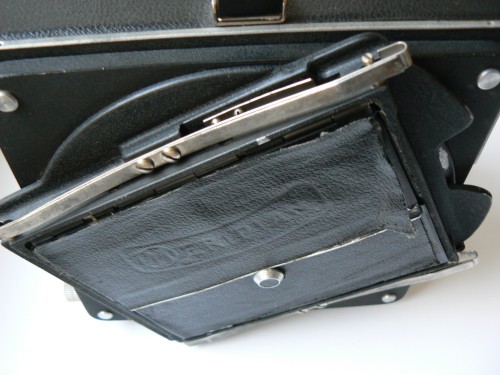
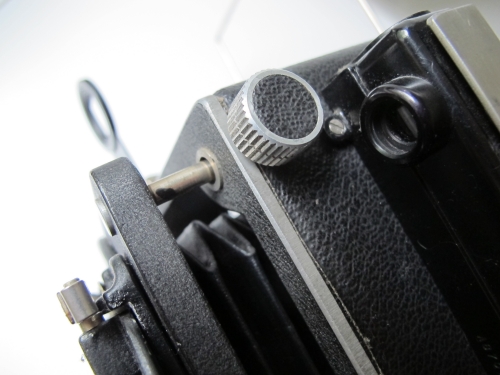
The revolving back can be
set on portrait or landscape at all the four 90 degree stops.
The side flaps of the
viewing hood are made of a stiff plastic material which is not very willing to
stay open when needed.
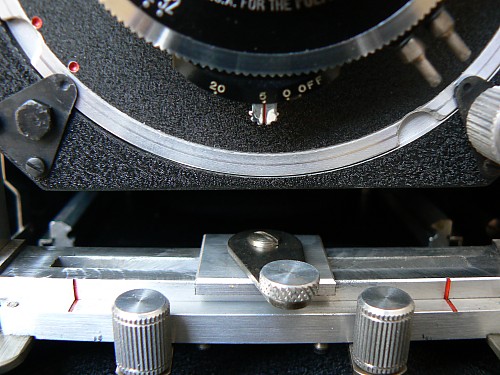
Unlike the usual square
lens boards of all the other Press Cameras, the Meridian lens board is round and
is locked by turning it anti clockwise until it snaps in.
In the middle
between the red stripes, the central
lever to allow shift and swing.
Both vertical handles if squeezed
together allow the lens standard to move for and backwards along the bed guides.
Undependable of the infinity stops or a lens standard lock, the lens standard
locks on every wanted spot on the rails just by letting the handles go free.
The
clever designed standard mechanism snaps in and the lens standard is locked.
On
the left the locked standard and the right in unlocked position.
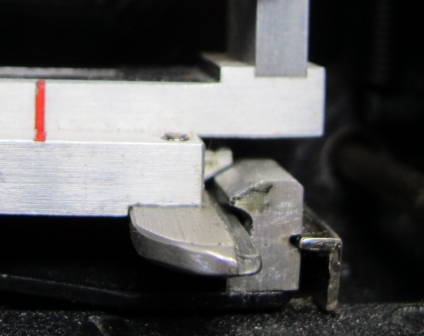

The Meridian has front
swings and shift, forward and backward tilts and triple extension bellows.
The
front shift is quite easy by turning the front standard lock a half turn to the
right.
The front standard can slide now from left to right or visa versa. The
shift moves in guide slots an therefore suggesting that there is no swing
possible at all.
However turning the centre screw a turn and a half
anticlockwise, the standard can be lifted out of the guide and can be swung in
each direction.
When found the right position you may turn the centre screw back
until it holds its position.
To be able to turn the centre lock, the lens
standard should be moved upwards.
McKeown's guide says that Meridians have
front swings, and when I got mine I was disappointed at first because I thought
they had it wrong.
I eventually figured out something that works, although I
don't know whether it's supposed to or not, as I don't have a manual.*)
I get
front swings by backing off the same lever that allows shifts, but undoing it a
turn-and-a-half instead of half a turn.
The front standard can then be lifted
about half a millimetre out of its guide slots, and will swing left or right by
about 20 degrees.
It can be locked by tightening the same lever about 1/2 turn.
Lifting the standard out of its guide slot does add a tiny bit of rise to your
swing, but in practice I don't usually even notice the difference.
It also means
that swings of less than about 3-4 degrees are not possible, as the rails tend to
drop back into place.
I find a similar problem with my SSG, which has a centre
detent spring that has a nasty habit of popping back into the locked
position
when I am fiddling with small amounts of swing while doing macro shots, so the
Meridian is no less useful for this.
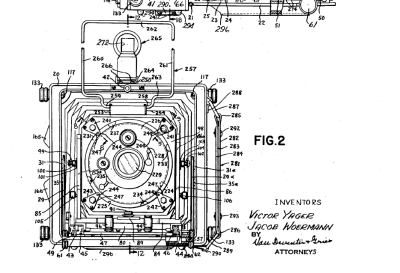
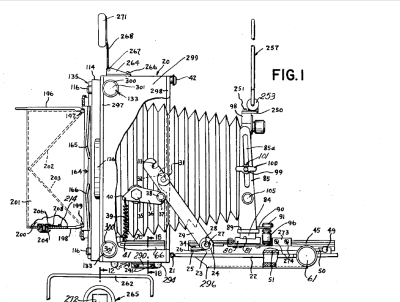
*) In the mean time Jamie Brown from Iowa City IA sent me a
copy of his original 1948 Meridian manual
which I'm pleased to share with you.
Meridian manual